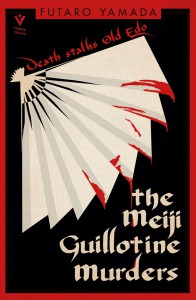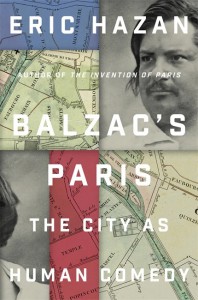Exciting destinations are in your future with these selections from some of the most delightful new publications in world literature. Futaro Yamada takes us back to nineteenth century Japan with a scintillating mystery of imperial intrigue and murderous plots; and Eric Hazan takes us along the streets and districts of a Paris as seen by one of its most vital figures: Honoré de Balzac. Read on to find out more, and bonne journée!

The Meiji Guillotine Murders by Futaro Yamada, translated from the Japanese by Bryan Karetnyk, Pushkin Vertigo, 2024
Review by Mary Hillis, Educational Arm Assistant
A driverless rickshaw, a bizarre sighting through binoculars, a corpse holding its own head—these are a just few of the perplexing scenarios that Chief Inspectors Toshiyoshi Kawaji and Keishirō Kazuki investigate in The Meiji Guillotine Murders by Futaro Yamada (pen name of Seiya Yamada).
The story begins in Japan after the Boshin War, in which the several domains fought against the Tokugawa Shogunate to restore imperial rule. During the Meiji period, strides to modernize the country continued, resulting in tumultuous changes to the economy, politics, and society. As officers of the Imperial Prosecuting Office, Kawaji and Kazuki are concerned with these developments, especially the role of justice within the new government. Both men are dedicated to their convictions, and early in the novel, Kazuki contends:
Corruption is, after all, the muddying of the distinction between the public and the private, between right and wrong. That’s why the public lost faith in the shogunate. Truly, it’s a good thing that it fell. And yet, the newly formed government is already showing signs of corruption. You ought to know this better than anyone. Otherwise, what was the point of our revolution? Or will there be another, and then another? Would it not be absurd to go on repeating it for all eternity? The government doesn’t exist merely to protect the people. Its aim must be the embodiment of justice.
One way Yamada renders this transformation and the accompanying influx of imported ideas and innovations is through the characters. Kawaji is based off of a real-life figure, the eponymous man who traveled as part of the Iwakura Mission to study systems in Western countries, and who is recognized as the founder of the modern police force in Japan. Kazuki, meanwhile, is a fictional character who returns to Japan from France to introduce the guillotine, and as the book’s title suggests, its chilling presence looms over the novel. There is a great deal of curiosity surrounding the new execution device, and when it is demonstrated at the prison, he addresses the doomed inmate:
“You are to be put to death, but in this enlightened age you shall be beheaded in the French fashion,” Kazuki boomed, as he clutched the hanging rope. “At least you shall have the honour of being the first in Japan to be subject to an experiment of this kind.”
In addition to Kawaji and Kazuki, another recurring character is Esmeralda Sanson, a French woman with an interesting family background. She is in the country working on translation projects; nevertheless, local residents are surprised to hear her speaking Japanese or singing ancient kagura songs. Often dressed as a shrine maiden, her features are captivating and give her an aura of mystique.
To Kawaji, her wide blue eyes seemed like a pair of mysterious jewels. Though he had seen them before, he could not help feeling mystified that such a beautiful creature could exist upon this earth.
After the introductory chapters, Kawaji and Kazuki investigate a confounding series of murders which juxtapose the old and the new: “A Strange Incident at the Tsukiji Hotel”; “From America with Love”; “The Hanged Man at the Eitai Bridge”; “Eyes and Legs”; and “The Corpse that Cradled its own Head.” Each begins with an excerpt from their reports filed with the Imperial Prosecuting Office, and finishes with a dramatic appearance by Esmeralda. These five baffling cases drive the narrative forward until they are ultimately connected and resolved in the final chapter.
At times, the extensive background information and cast of named characters—including a group of rasotsu (patrol men)—threaten to become overwhelming. Yet it is these very details that create an ideal environment for readers to become completely immersed in the story. Yamada, also well-known for his ninja series beginning with The Kouga Ninja Scrolls, is a master of incorporating history into his work. Of crime fiction in general, critic Geoffrey O’Brien contends, “To be drawn in was to breach the boundaries of embedded histories—echoes of real crimes, intimations of crimes not yet committed—that would saturate your life.” Indeed, reading The Meiji Guillotine Murders is to experience these reverberations of these new technologies and evolving situations in late nineteenth-century Japan.
In “A Strange Incident at the Tsukiji Hotel,” for instance, a body that has been split apart by a sword is discovered in the hotel lobby. At the scene of the crime, clues related to the murder are found, but they don’t seem to add up. Then, from the hotel tower, Kawaji, Kazuki, and Esmeralda regard the panoramic view of the surrounding foreign settlement. From this vantage point, the changing landscape of the country is palpable, and Yamada borrows a description of the setting from Samuel Mossman’s 1873 book New Japan.
The . . . campanile tower sixty feet high, which commanded from its enclosed top an extensive prospect of the capital—now called Tokyo, but which will always be named Edo by foreigners—the magnificent Bay of Edo, and the native-adored mountain of Fuji-yama rising grandly in the distance. . .
The Meiji Guillotine Murders, originally published in 1979 and recently translated by Bryan Karetnyk, is distinct for its density of historical and political detail, taking readers back to an earlier time in Japan’s history—an era marked by change and intrigue.

Balzac’s Paris: The City as Human Comedy by Eric Hazan, translated from the French by David Fernbach, Verso, 2024
Review by Christina Chatzitheodorou, EaL for Greece
Eric Hazan has brought nineteenth-century Paris back to life—not anyone’s Paris, but that of Honoré de Balzac. Hazan, a born and raised Parisian, has previously written about the city, bringing in altered images and sociocultural narratives. In The Invention of Paris, Hazan takes us on a trip into the radical past, walking through the streets of the French capital in times of conflict, political upheaval, and the imaginary construction of utopias. Another of his texts, A City between Past and Future, explores the city’s continual changes, and how its people become both the perpetrators and subjects of these shifts. Now, in bringing one of its most celebrated figures to the forefront, Hazan does not solely narrate the Parisian soul, but how it lives through a reciprocal relation with Balzac and his writing. A city indeed is not a lifeless space, but one that transforms its occupants and is transformed by them in turn. It lives vicariously through the lives of its residents, and each one lives in a different Paris.
Balzac’s Paris: The City as Human Comedy concentrates on different themes—streets and neighbourhoods, the Parisian press, and the theatre scene of the time. Through a close reading of Balzac’s most important works, the themes are additionally explored vis-à-vis Balzac’s life story, providing a double reading and surprising connections. In a chapter entitled “Quarters”, Hazan maps out the blocks and avenues of The Human Comedy, Balzac’s collection of novels and stories, and brings the enduring streets and the imagined characters together: “In The Human Comedy, Rue Taitbout, which Louis Chevalier sees as the most Balzacian street in Paris, is the street of happy love. The hero of A Second Home, Roger, extracts the beautiful Caroline from the darkness of Rue du Tourniquet-Saint-Jean and installs her on Rue Taitbout.” And in “At the Theatre”, Hazan explores how the city itself affected Balzac—the transformation enacted upon the author rather than his novels’ heroes. In his recount, Balzac loses his way when it comes to the 1840s, as he sees theatrical plays as a capitalistic, rather than artistic, endeavor: “This perfectionist disappears as soon as Balzac writes for the theatre. For him, this was an activity designed to earn money.”
Exploring the places Balzac wrote about and where his heroes walk—Hazan brings back to life the quarters that were shared by the creator and his protagonists. What results is an exploration of the city’s vastly different areas; people of different classes appear, and one comes to understand the intersection between their oppressive experience and where they actually exist. As Hazan writes, “The notion of quarter is given its meaning by the social status of its inhabitants.” Each quarter has its own group, but that does not mean “migrations” do not take place, from the top to the bottom and vice-versa. It’s the people who make the place and not the other way around: “Students, aspiring writers, journalists, artists, dreamy philosophers . . . .”
Literature always exists in a dialogue; no author exists alone in the world of letters, but rather always in a discussion with his precedents, contemporaries, and the ones who will follow. Thus, Hazan looks into Balzac’s relationships with contemporaneous literary figures of 1830s-1840s France—George Sand, Victor Hugo, Lamartine, and others. Sand, for one, “quickly fell under his spell,” and Hazan quotes a letter in which she gives high praise: “Oh! you would have understood the fascination of M. Balzac or you will never understand anything about the magic of the gaze and the sympathy of souls.”
Among Hazan’s most interesting aesthetic interventions, however, is the more in-depth reading of Balzac’s politics regarding the throne and altar: “Balzac praises the Catholic religion, but what it represents for him is a means of maintaining the social order.” Discussing how Balzac is positioned vis-à-vis the political affairs of 1830s/40s Paris, Hazan dives into both his criticisms and his beliefs. A friend of order, Balzac critiques the July Revolution of 1830 when it led to the overthrow of King Charles X, as well as the shift to constitutional monarchy through the ascent of his cousin Louis Philippe: “The disasters of July 1830 came, society was dissolved for two years.”
As such, the book provides an ode to an intricate metropolis—but as it exists through an equally complex writer. “Balzac’s relationship with Paris is unique. Other great authors have written about Rome, Berlin, or London, as well as Paris, but none of them would have dared to say anything like this: ‘For me, there are memories at every door, thoughts at every lamppost. Not a façade has been built, not a building knocked down, but that I have not spied on its birth or death. I take part in the immense movement of this world as if I had its soul.’”
*****
Read more on the Asymptote blog:

